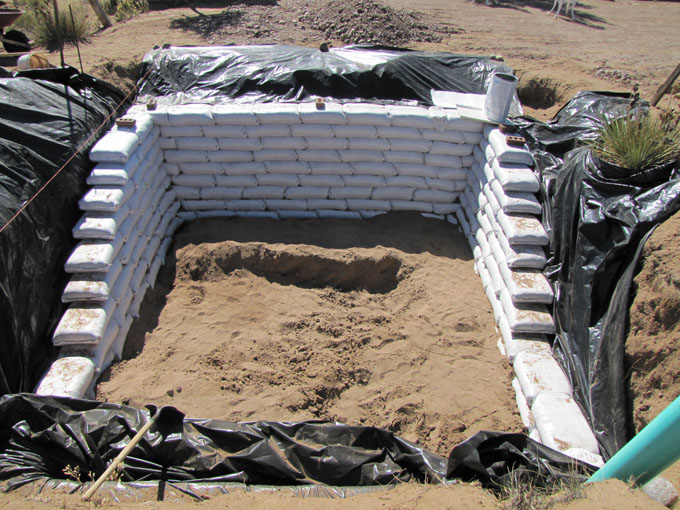My last blog post was about a free online version of Making Better Building by Chris Magwood. In reading through some of his introductory comments about foundations, I came across this statement: “In much of North America, foundations have been twinned with conditioned, subgrade living space: the basement. In many markets, having a basement is so normal that it can be hard to convince a homeowner to imagine a house without one. It is difficult to create a sustainable basement and — unless the home is in the driest, best draining of soils — impossible to create a basement that doesn’t rely on several layers of petrochemical products to stay dry”
While I agree that there are definitely challenges in building ecological basements, I question his suggestion to avoid them altogether. From my perspective the value of below-grade living space is extremely high, what with the moderating effect this has on creating comfortable living temperatures, and thus the energy inputs required for both heating and cooling the space. Nearly everywhere on Earth digging into the ground has the potential to save energy and create more comfort. I consider it one the most sustainable of all building practices, especially as we go forward with our changing climate.
So I wrote to Chris and asked him what he thought about this.
This is his response:
I agree with you on a conceptual level… there are definitely benefits to being below grade to some degree or another. That’s why I don’t say to avoid these spaces altogether, but rather that using “bad” materials is typically necessary. I don’t want to greenwash the idea, because in a North American context it’s nearly a guarantee that concrete, foam and toxic coatings are going to be used. I see way too many “green building” advertisements for foam ICFs! For the small handful of people who will actually carry through with a truly green sub-grade foundation, there are literally hundreds of thousands that will continue to wreck our planet. The book does call out those options that are more sustainable, but in general I think that encouraging people to go below grade is encouraging the use of the worst materials on offer.
Well, I still think that basements and underground or bermed housing should be vigorously encouraged… but only if they are built with sustainable materials, like earthbags, such are shown below. You can see that I did use a polyethylene liner, but I think that this a very minor part of the project when compared to the decades of utility and thermal value for this space.
What do you think?


How would you go about building a multi floor basement with alternative materials? What I mean is where you have one or more sub-basement levels below your upper, but still underground basement.
Both earthbags and stones can be used safely below grade, so with proper engineering, several such basements could be built.
I guess it depends on the location.
Hi Kelly, I’m thinking about building an earth-coupled house. This model was put forward in a book (1983) by John Hait called “Passive Annual Heat Storage.” I’m not sure why it didn’t catch on. The idea is to insulate a column of earth around the house as opposed to insulating the house from the earth. When combined with geothermal ventilation and passive solar it could theoretically hold to around 65 degrees year-round by itself. I know that Paul Wheaton has experimented with it and branded his own version called WOFATI. The author himself supposedly tested it at a place called the Rocky Mountain Research Center which seems to be no longer extant. It would rely on EPS foam or perlite or some form of undergroundable insulation. If there was ever a worthwhile deal with the Devil, could this be one?
I am aware of that book and concept, and think it is a great idea. It is really quite similar to what the traditional Earthships do by buffering the back tire walls with a hefty insulated berm. You can see a diagram of this at http://greenhomebuilding.com/earthship.htm#plan
I working on a design for an earth bermed cabin with a living roof. I live in a small cob and light clay straw house and even though I do get some temperature moderation from the wall mass, extended roof eaves and sunward facing windows it does require moderate external heating and cooling.
I’m hoping the earth bermed cabin will have only minimal heating and cooling needs if any. I do live in central Texas and the humidity can be fairly high for extended periods of time so I think the cabin will probably need a (probably mechanical) dehumidifier.
I’m planning to build the cabin stick frame infilled with light clay straw on the non-bermed sides and lime stabilized cob on the bermed ones. I’ll use pond liners to waterproof the roof and the bermed walls.
I agree that the use of non-sustainable materials is justified in this case since it results in a structure that will have very low energy and maintenance needs.
Earthen materials can withstand humidity better than most building materials, so if you include some interior earthen plaster this might help with humidity.
We have earthen plaster throughout our house and lime plaster in the bathroom and humidity doesn’t seem to be an issue. However, we built a cob shed with an earthen floor several years ago and there have been issues with tools rusting in there.
With the new build I’ll plan to have wiring and a condensate line in place in the event I need mechanical dehumidification. I’m also thinking about using lime plaster more broadly in the interior.